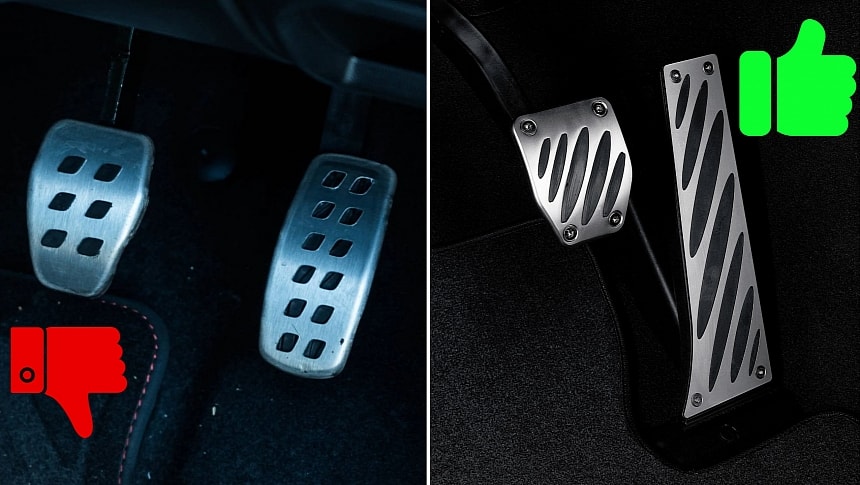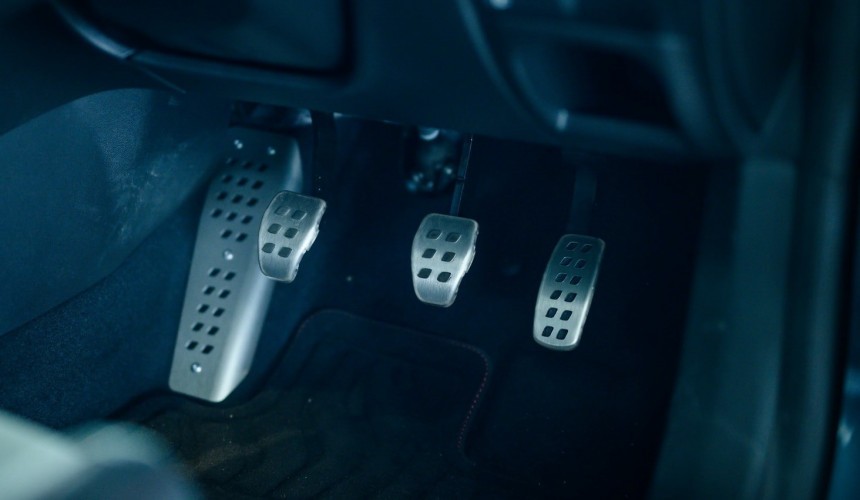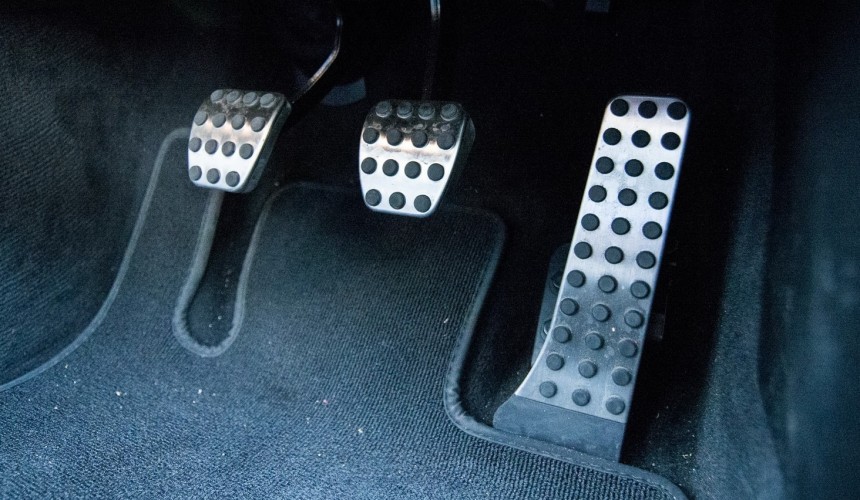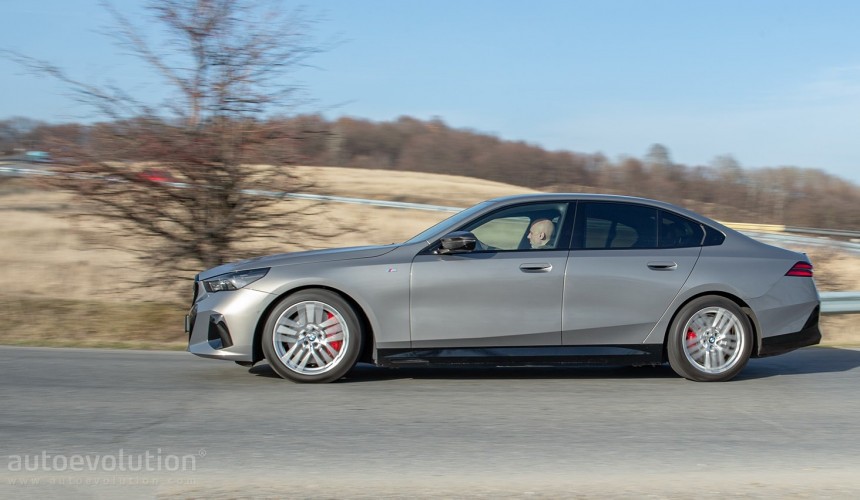What goes into making a good accelerator pedal? Some people call it a ‘throttle’, others a ‘gas pedal’, but regardless of what you call it, you often don’t even pay it any consideration. It’s just there to help you accelerate or decelerate.
Back in the day, getting on or off the throttle meant regulating the amount of air and fuel allowed to enter the engine. However, in modern cars, you’ve got the ECU for that, also known as the Engine Control Unit. Anyway, I’m not here to give you a mechanical breakdown, but rather one pertaining to ergonomics.
What would you say if told you that you’ve been putting unnecessary pressure on your foot for years, maybe decades, by driving cars with suspended pedals – meaning top hinged. By design, the pedals can be either hinged at the top, or the bottom (also called floor-mounted, or organ-type), and believe it or not, the way in which they’re hinged can have a substantial effect on your driving experience, especially if you spend a lot of time behind the wheel.
Think about it – the gas pedal is a critical interface between driver and car, dictating not just responsiveness but also, to varying degrees of extent, comfort. Let’s run through each of the two designs.
This type of pedal is anchored from above and some people would argue that they are more naturally aligned with your foot. Basically, when driving, the natural arc of the foot aligns more closely with the motion required to depress such a pedal. Furthermore, a top-hinged pedal is said to also encourage you to rest your heel on the floor, thus promoting a more stable and consistent driving posture.
Some examples of cars with top-hinged pedals: pretty much the vast majority of non-premium / non-performance vehicles, but this isn’t a hard-and-fast rule. Audi also uses top-hinged pedals on their entire range basically, the only exception being the R8. Another performance car with a suspended gas pedal is the Dodge Challenger SRT Hellcat and all of its variations.
The issue, however, is that you don't always keep your heel on the floor properly and you end up tensing up your foot and ankle. These types of pedals are also physically smaller, and your foot can slip on rare occasions – say maybe you’ve just come back from the beach and you’re wearing slippers. Not saying you should be driving in slippers, but these more "conventional" pedals certainly don’t make that easy.
In terms of actual pros, top-hinged pedals are thought to sometimes offer better safety margins in emergency situations, seeing as how it allows you to apply full pressure faster. Also, they say these types of pedals are more user-friendly in city traffic, because of the smoother, more linear throttle response – basically, the natural foot movement required for top-hinged pedals allows for easier modulation of speed.
With floor-mounted pedals, we’re talking about a completely different type of foot movement. Since the pivot point is at the base 100% of the time, you’ll find yourself pushing downward more than forward. I would argue that it’s a more comfortable movement. This is your typical sports car pedal. A design used in classic muscle cars, race cars (even Formula 1 cars), and a lot of premium cars, like Bimmers and Benzes.
Such gas pedals are positioned exactly where the driver’s foot would naturally rest, and they also reduce your chances of stepping on the wrong pedal when reacting quickly – speaking of safety. Ergonomically, this is the superior product. In terms of comfort too, because on long drives, your foot will become less tired.
Don’t just take my word for it, Mazda did some research of their own on this very topic a good while ago:
“There are two major muscle groups in the lower leg with the muscles along the shin responsible for raising the foot upwards toward the body and the muscles of the calf at work when you stretch your toes away. These larger muscles are the ones used when you press down on the accelerator and if the accelerator has sufficient counterforce to balance the weight of the leg, it is quite possible to operate the accelerator using only these muscles.”
Have you ever experienced shin pain after a long drive? This isn't the start of a drug ad, I swear. Shin pain can happen when the movement of the foot from a fixed-heel position doesn’t match that of the pedal – and with suspended pedals, it doesn’t, forcing you to use both your calf muscles as well as your shin muscles. Meanwhile, a floor-mounted gas pedal allows you to use only your calf muscles, which are larger and more powerful on average.
You also don’t have to deal with that pesky pedal counterforce found on most if not all top-hinged pedals. You’re pushing forward against those, instead of literally stepping on them, as you would a bottom-hinged pedal.
I’ve been doing this “car thing” for a long time now. I’ve driven all types of vehicles, over short and long distances, and while it did take me several years to understand how pedal design can directly impact driving experience, I eventually arrived at what I believe to be a clear conclusion. All cars should feature floor-mounted gas pedals. From sports cars to hypercars, sub-compact cars to SUVs and station wagons.
These pedals are way more forgiving on your shin muscles, their ergonomic superiority is beyond question, and they offer you a larger surface area to press down on. How is that not safer?
Of course, you’re not going to be doing any heel-toe shifting on public roads. This technique is mostly for track use, where your goal is to tackle corners at high speeds and keep the car balanced while downshifting.
What would you say if told you that you’ve been putting unnecessary pressure on your foot for years, maybe decades, by driving cars with suspended pedals – meaning top hinged. By design, the pedals can be either hinged at the top, or the bottom (also called floor-mounted, or organ-type), and believe it or not, the way in which they’re hinged can have a substantial effect on your driving experience, especially if you spend a lot of time behind the wheel.
Think about it – the gas pedal is a critical interface between driver and car, dictating not just responsiveness but also, to varying degrees of extent, comfort. Let’s run through each of the two designs.
Suspended / Top-hinged
Some examples of cars with top-hinged pedals: pretty much the vast majority of non-premium / non-performance vehicles, but this isn’t a hard-and-fast rule. Audi also uses top-hinged pedals on their entire range basically, the only exception being the R8. Another performance car with a suspended gas pedal is the Dodge Challenger SRT Hellcat and all of its variations.
The issue, however, is that you don't always keep your heel on the floor properly and you end up tensing up your foot and ankle. These types of pedals are also physically smaller, and your foot can slip on rare occasions – say maybe you’ve just come back from the beach and you’re wearing slippers. Not saying you should be driving in slippers, but these more "conventional" pedals certainly don’t make that easy.
In terms of actual pros, top-hinged pedals are thought to sometimes offer better safety margins in emergency situations, seeing as how it allows you to apply full pressure faster. Also, they say these types of pedals are more user-friendly in city traffic, because of the smoother, more linear throttle response – basically, the natural foot movement required for top-hinged pedals allows for easier modulation of speed.
Floor-mounted / Bottom-hinged
Such gas pedals are positioned exactly where the driver’s foot would naturally rest, and they also reduce your chances of stepping on the wrong pedal when reacting quickly – speaking of safety. Ergonomically, this is the superior product. In terms of comfort too, because on long drives, your foot will become less tired.
Don’t just take my word for it, Mazda did some research of their own on this very topic a good while ago:
“There are two major muscle groups in the lower leg with the muscles along the shin responsible for raising the foot upwards toward the body and the muscles of the calf at work when you stretch your toes away. These larger muscles are the ones used when you press down on the accelerator and if the accelerator has sufficient counterforce to balance the weight of the leg, it is quite possible to operate the accelerator using only these muscles.”
Have you ever experienced shin pain after a long drive? This isn't the start of a drug ad, I swear. Shin pain can happen when the movement of the foot from a fixed-heel position doesn’t match that of the pedal – and with suspended pedals, it doesn’t, forcing you to use both your calf muscles as well as your shin muscles. Meanwhile, a floor-mounted gas pedal allows you to use only your calf muscles, which are larger and more powerful on average.
You also don’t have to deal with that pesky pedal counterforce found on most if not all top-hinged pedals. You’re pushing forward against those, instead of literally stepping on them, as you would a bottom-hinged pedal.
Yeah, I don’t care
You really should though. There’s a reason why this design is often found in sports cars and all sorts of other performance vehicles, where there’s an emphasis on feedback and control. A floor-mounted pedal can enhance your connection to the car, and personally, I reject the notion that a top-hinged design boosts safety in any way. That just hasn’t been my experience at all.These pedals are way more forgiving on your shin muscles, their ergonomic superiority is beyond question, and they offer you a larger surface area to press down on. How is that not safer?
What about heel-and-toe shifting?
Ah yes. Everyone’s favorite performance driving technique. Interestingly, some people find it easier to heel-toe on bottom-hinged pedals versus top-hinged ones. However, others prefer the latter. This comes down to personal preference and whichever car you mastered this art in originally. Some habits are hard to break.Of course, you’re not going to be doing any heel-toe shifting on public roads. This technique is mostly for track use, where your goal is to tackle corners at high speeds and keep the car balanced while downshifting.
















